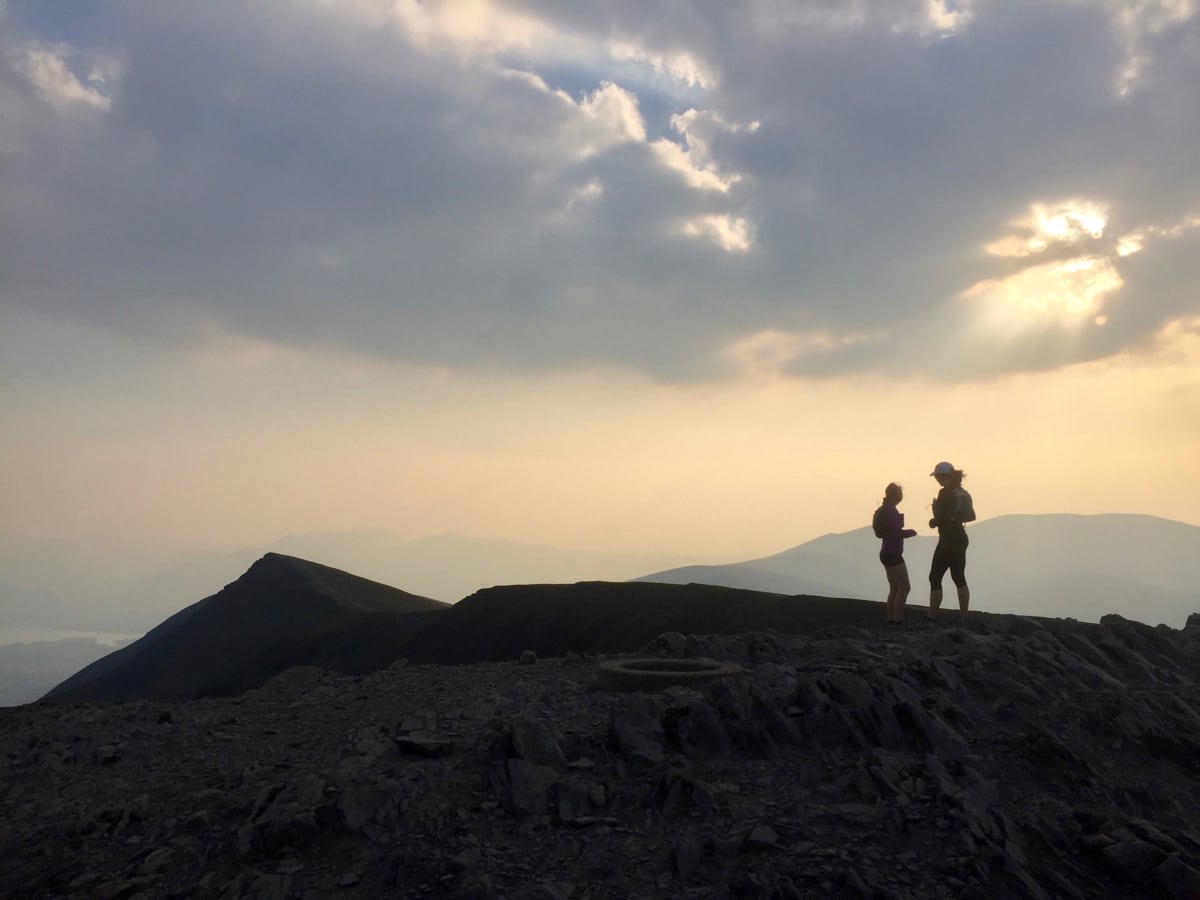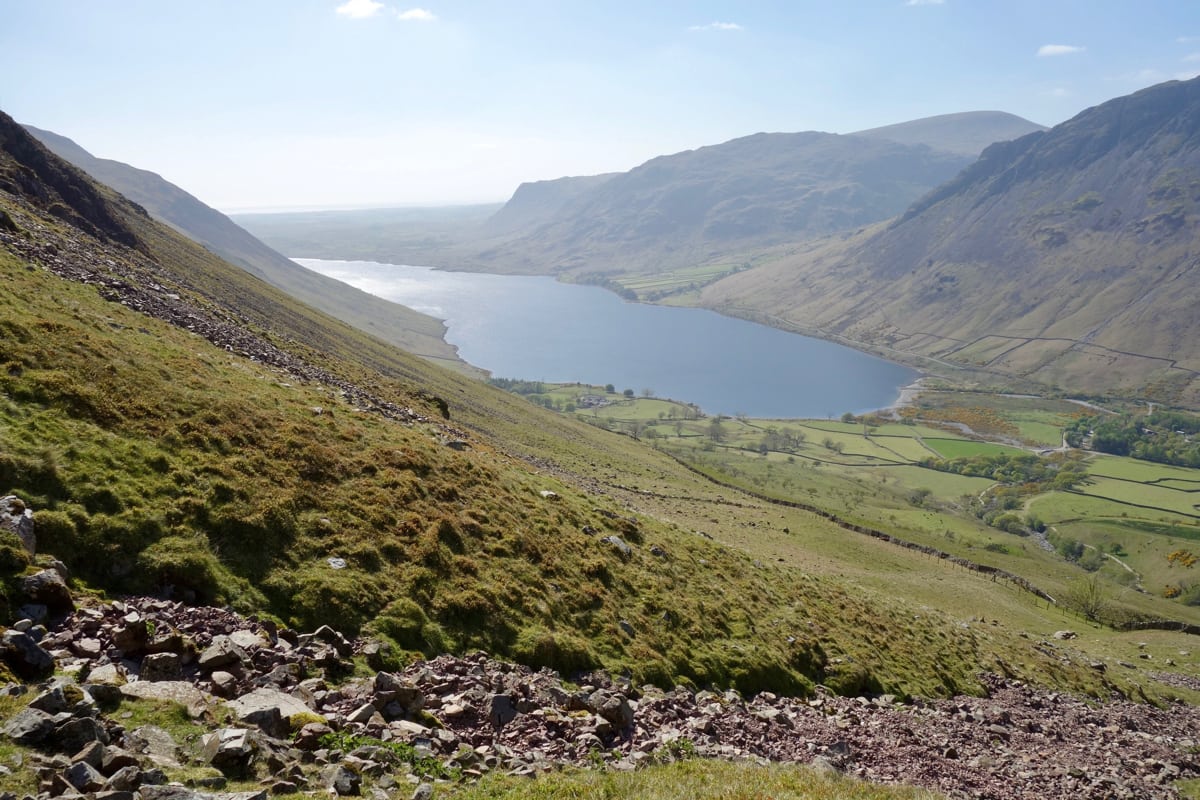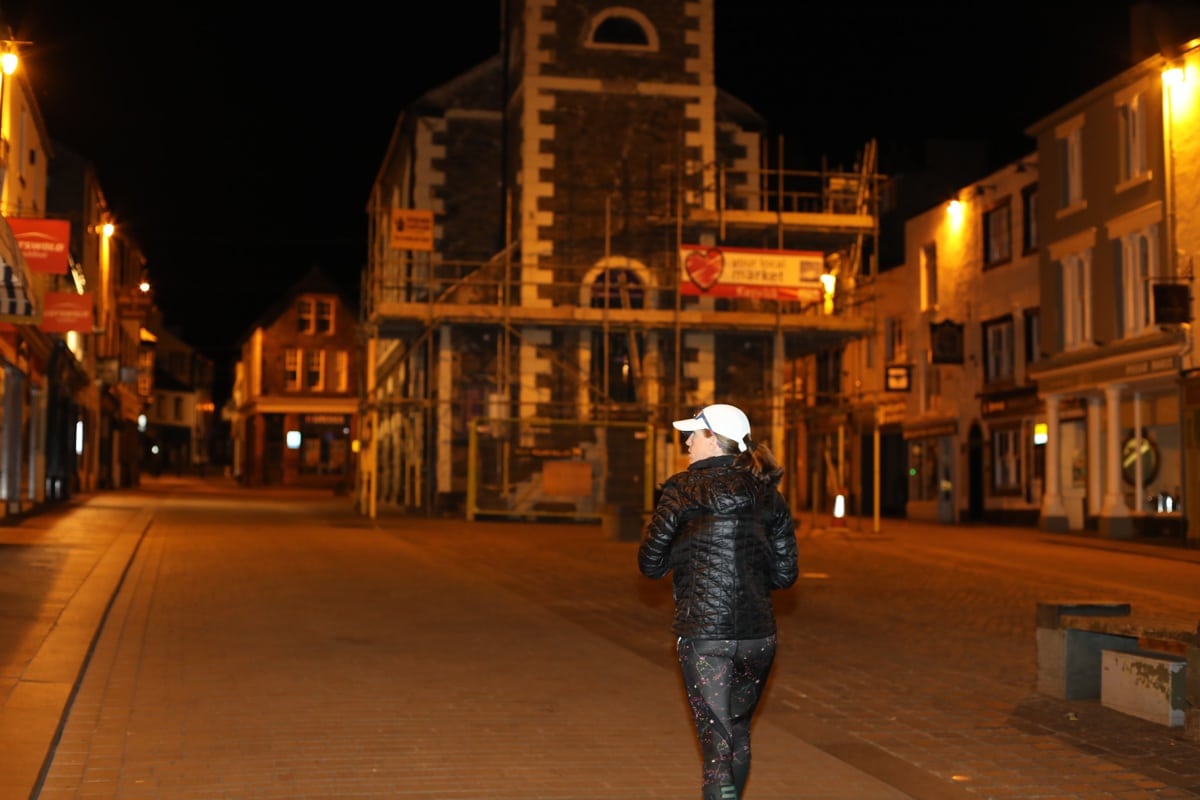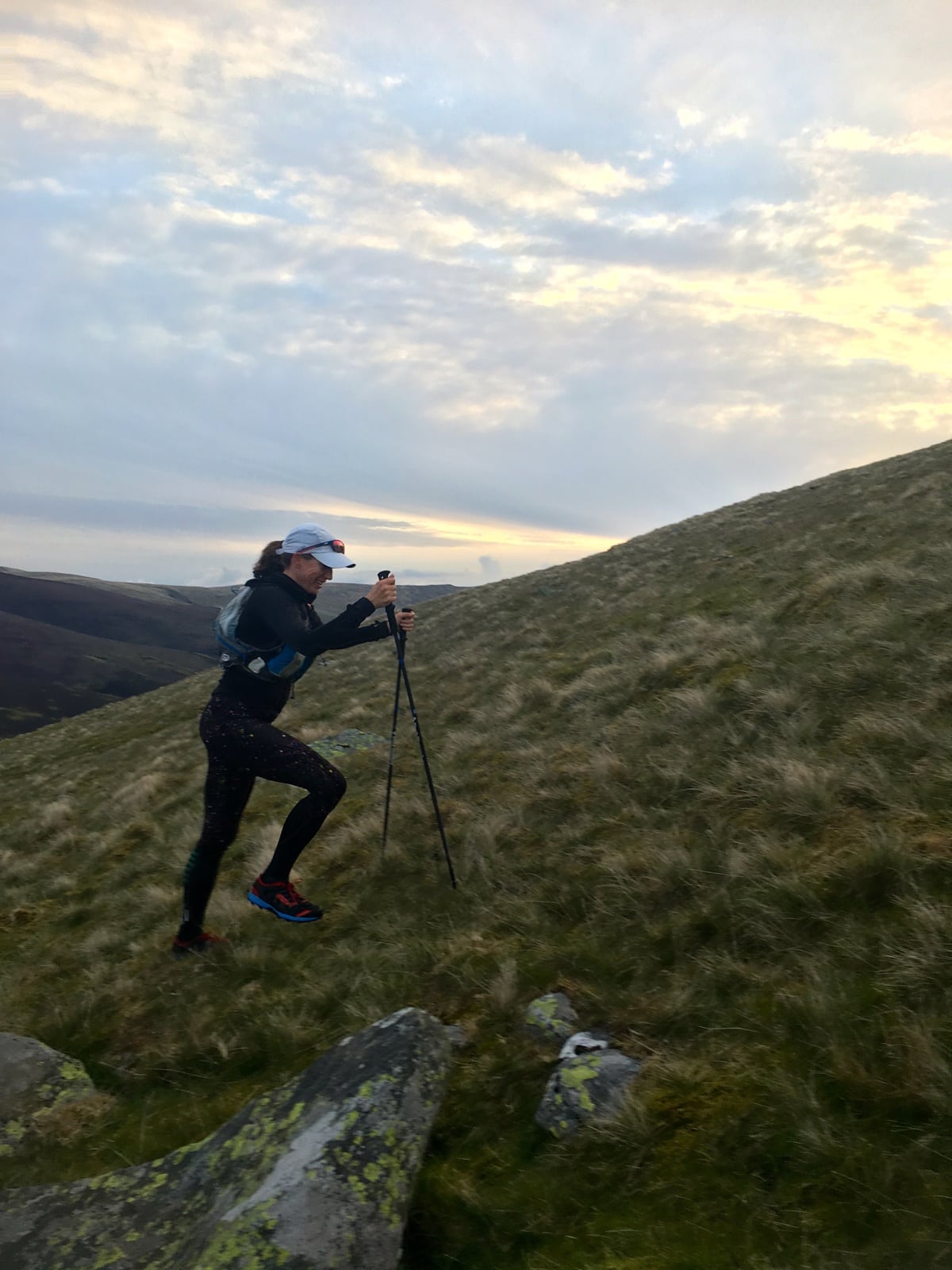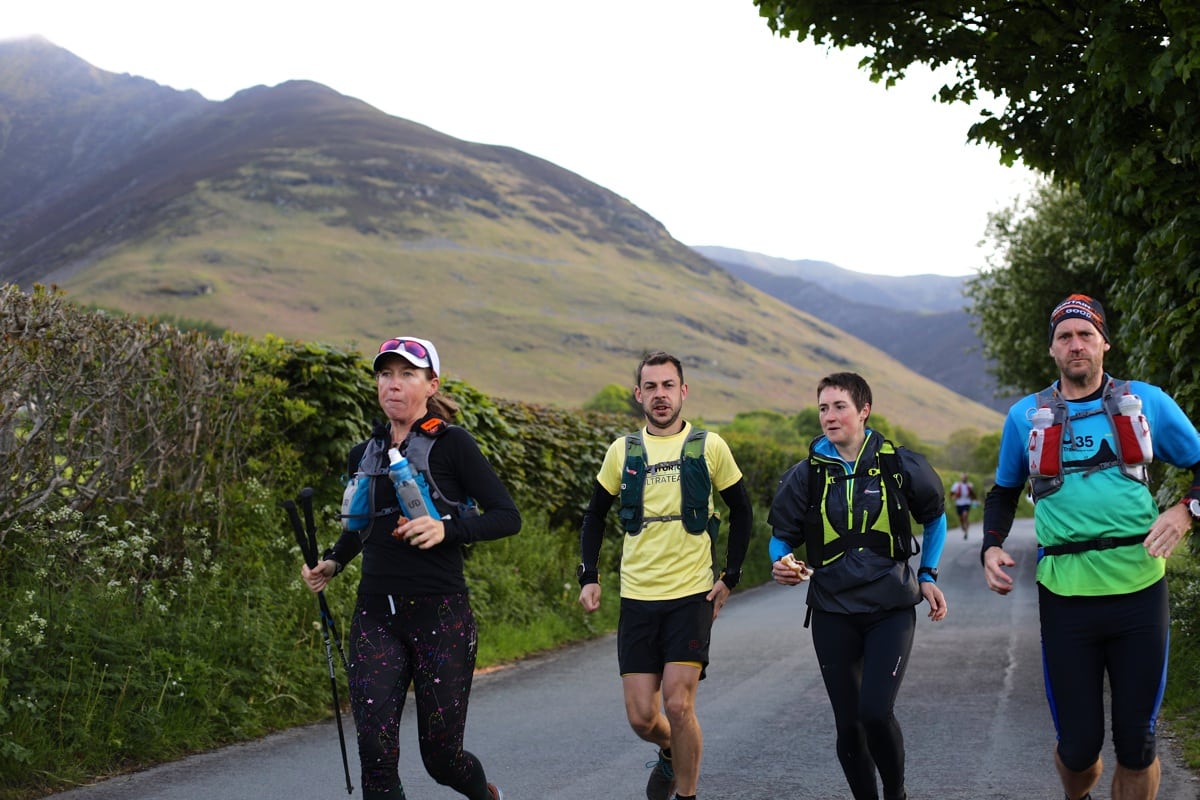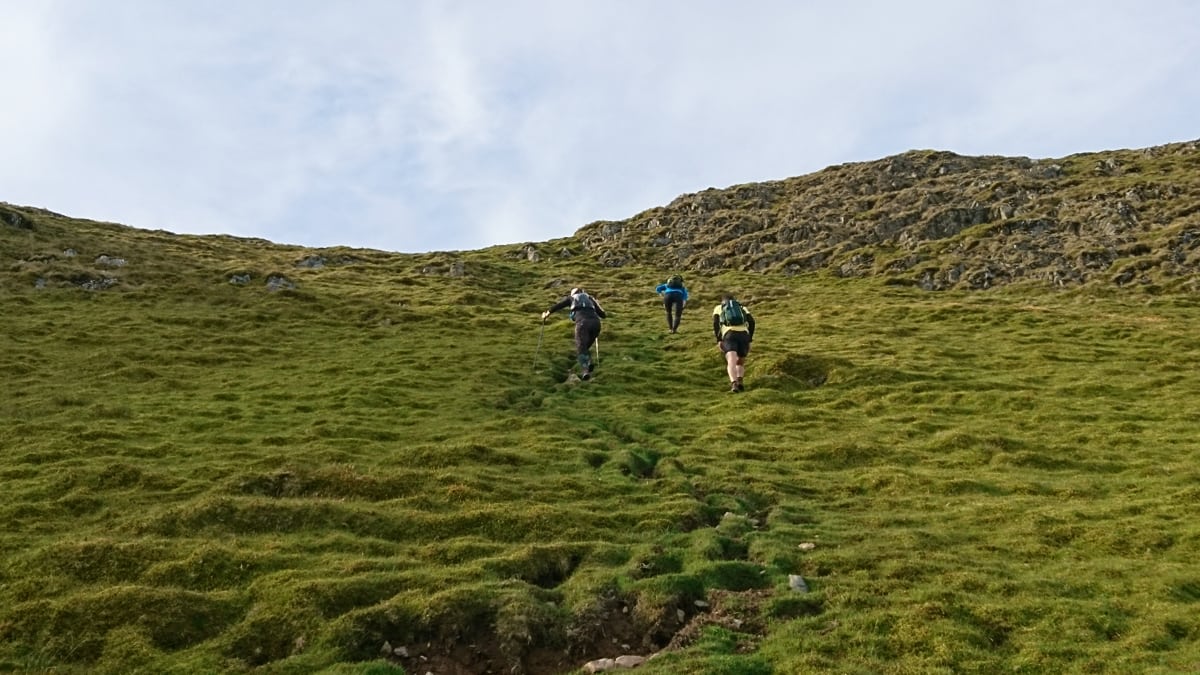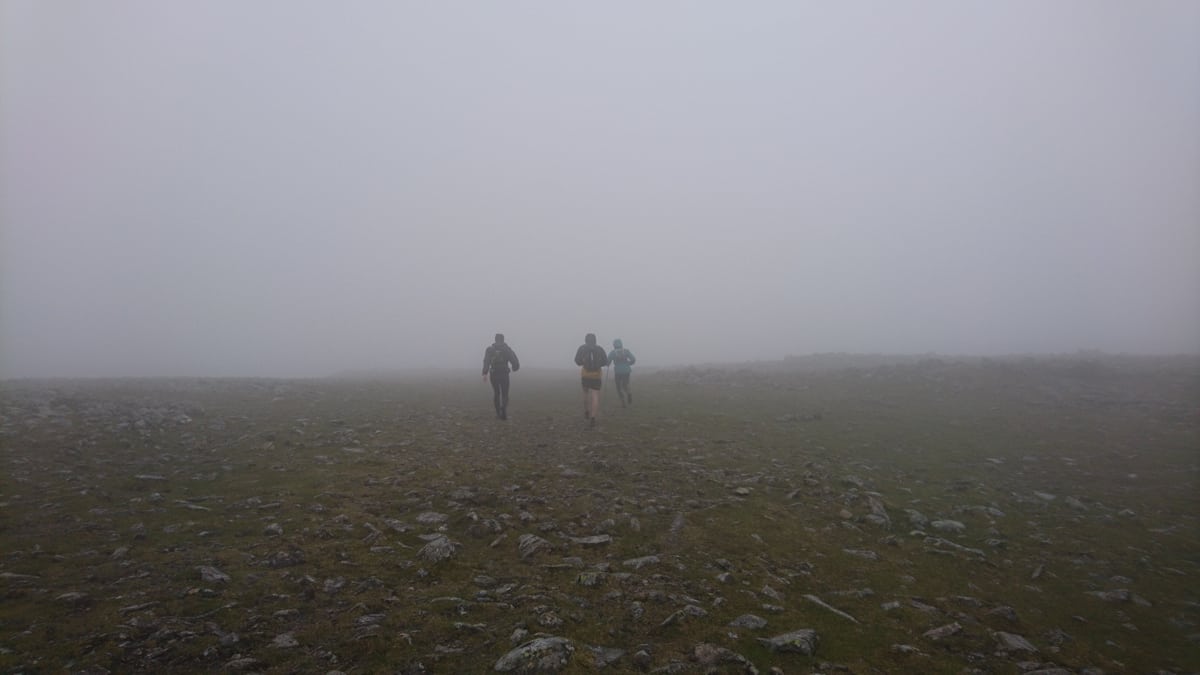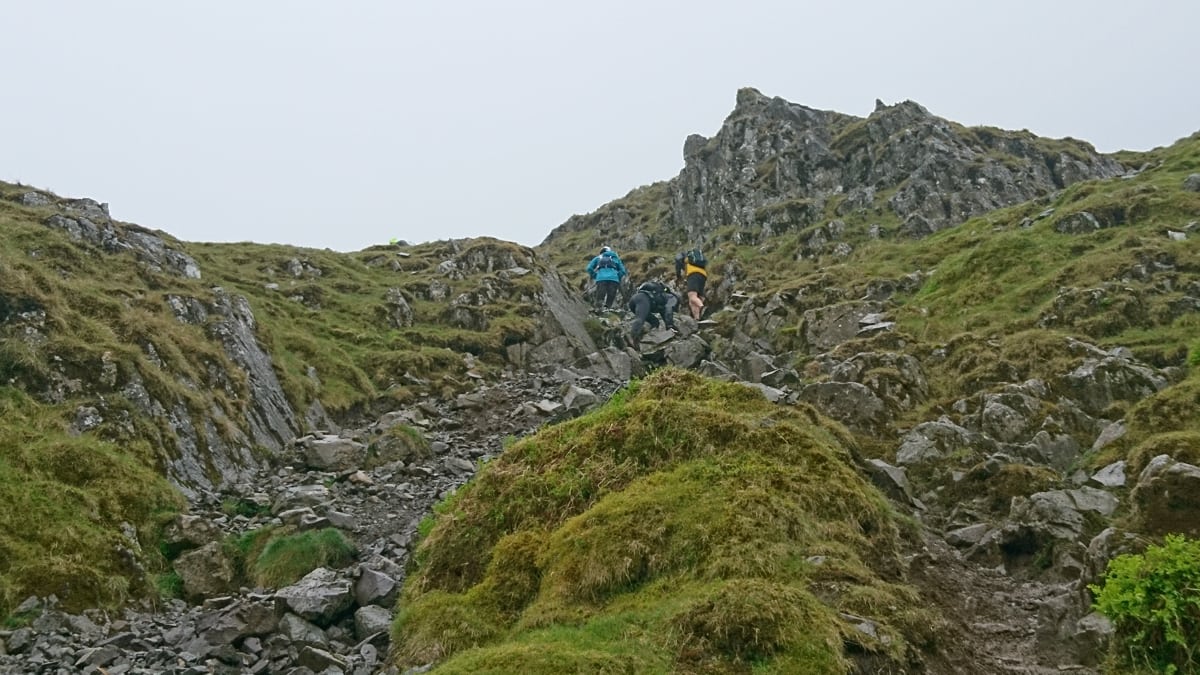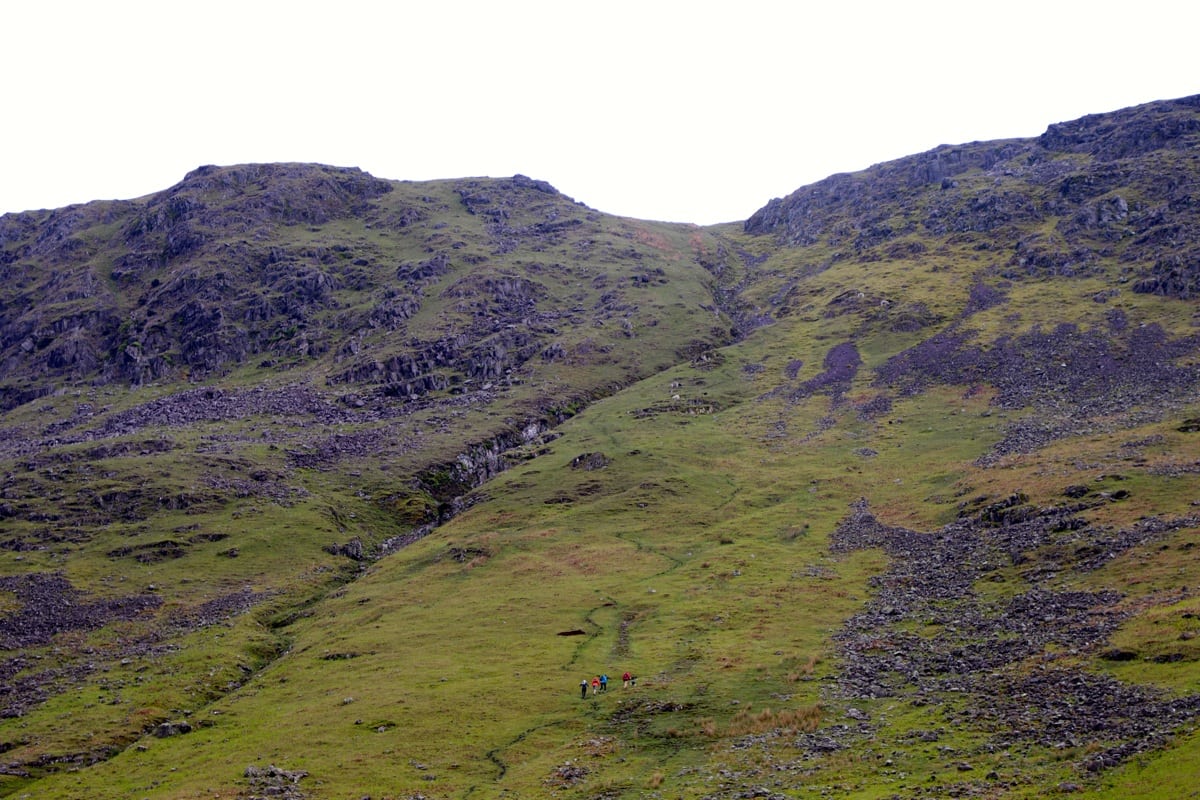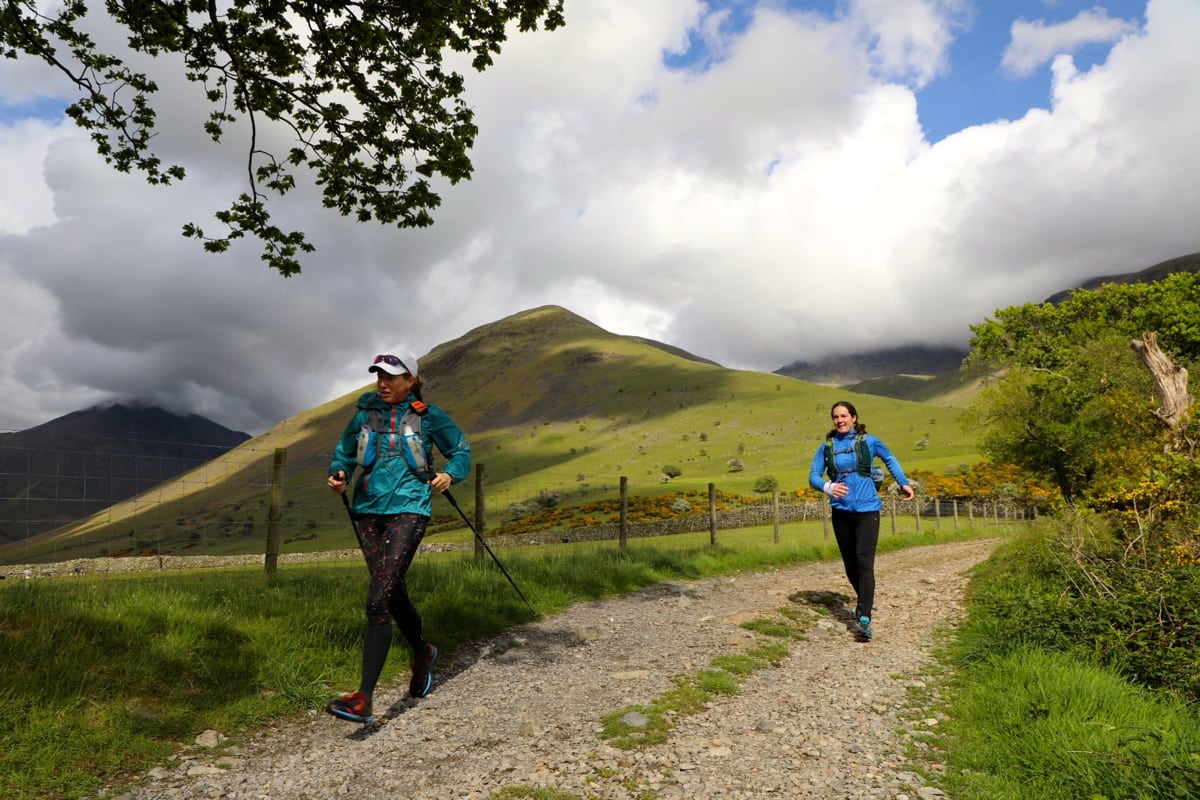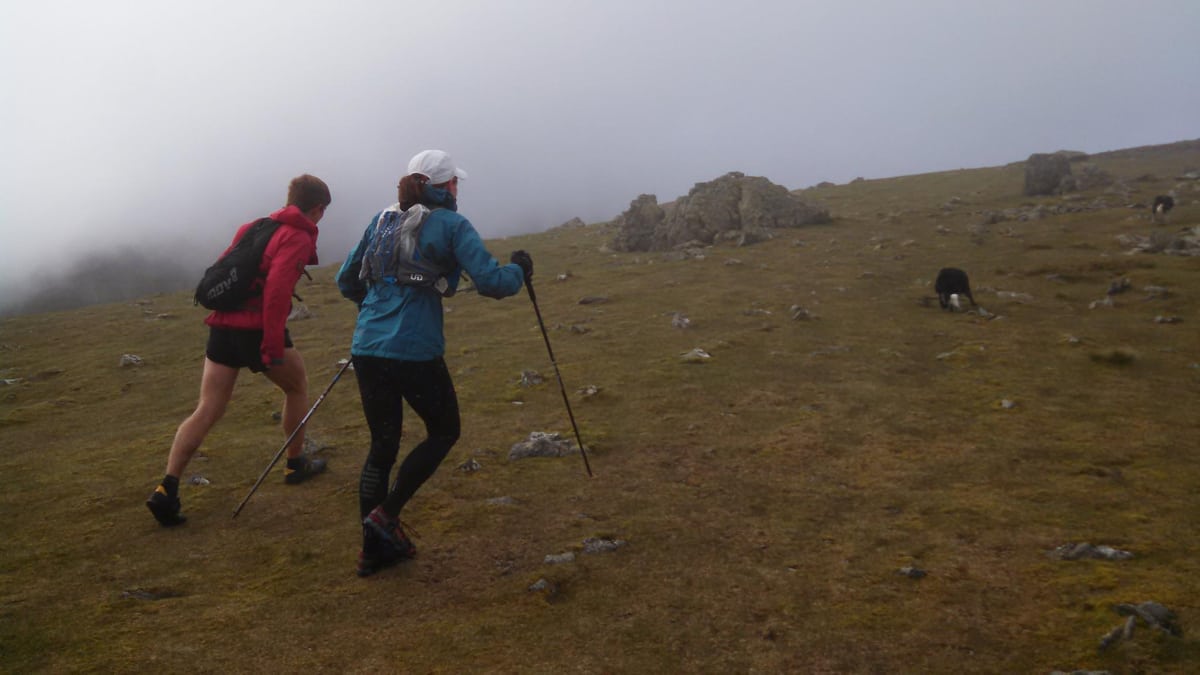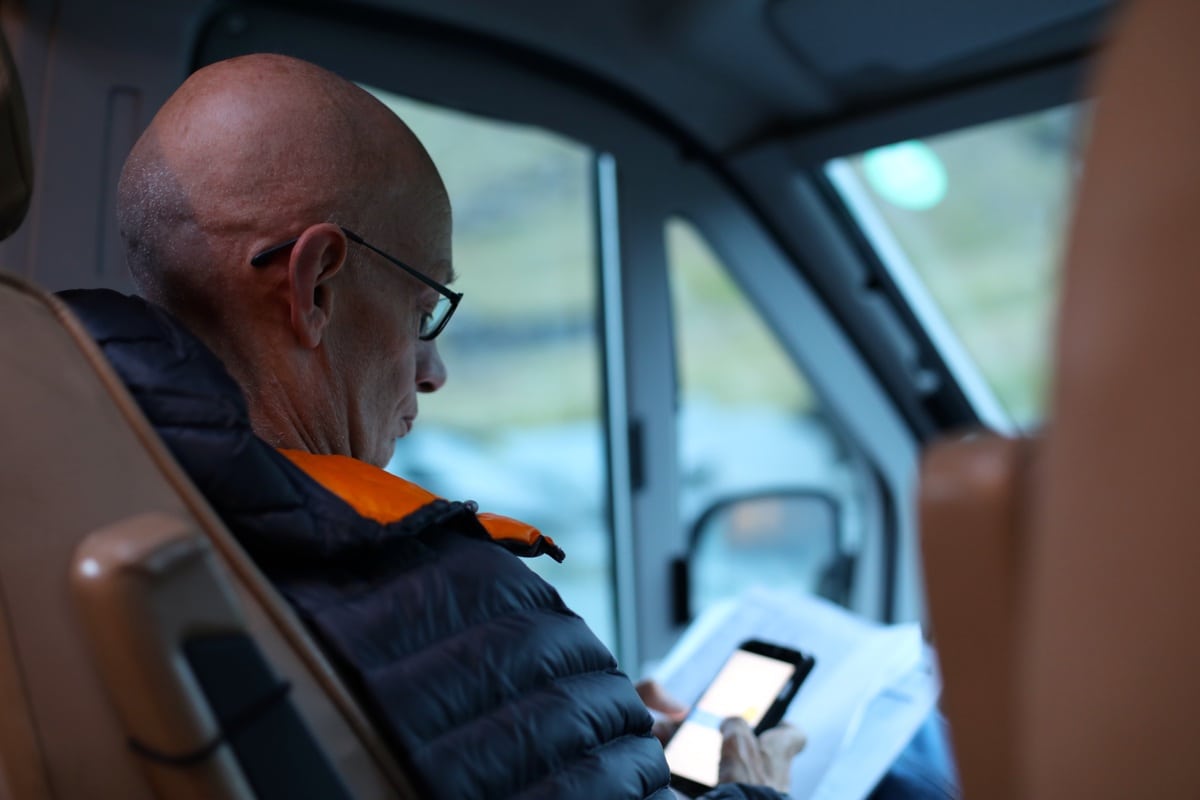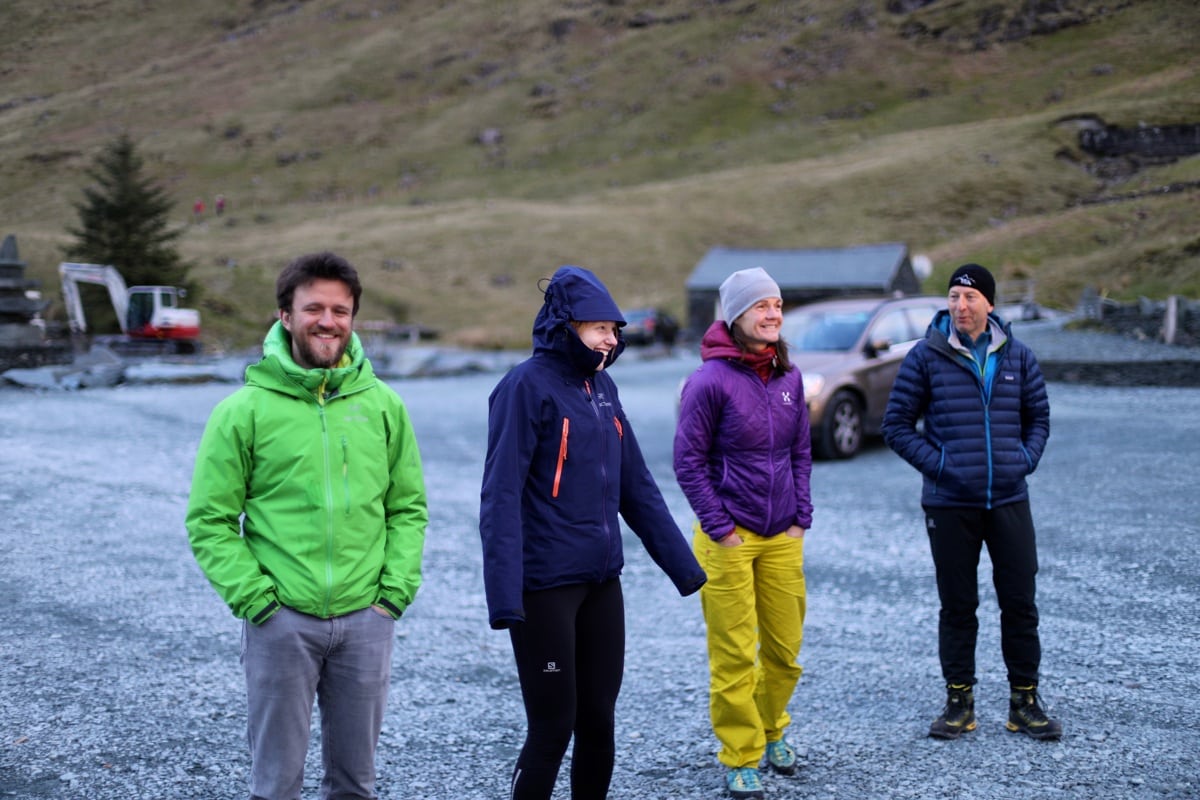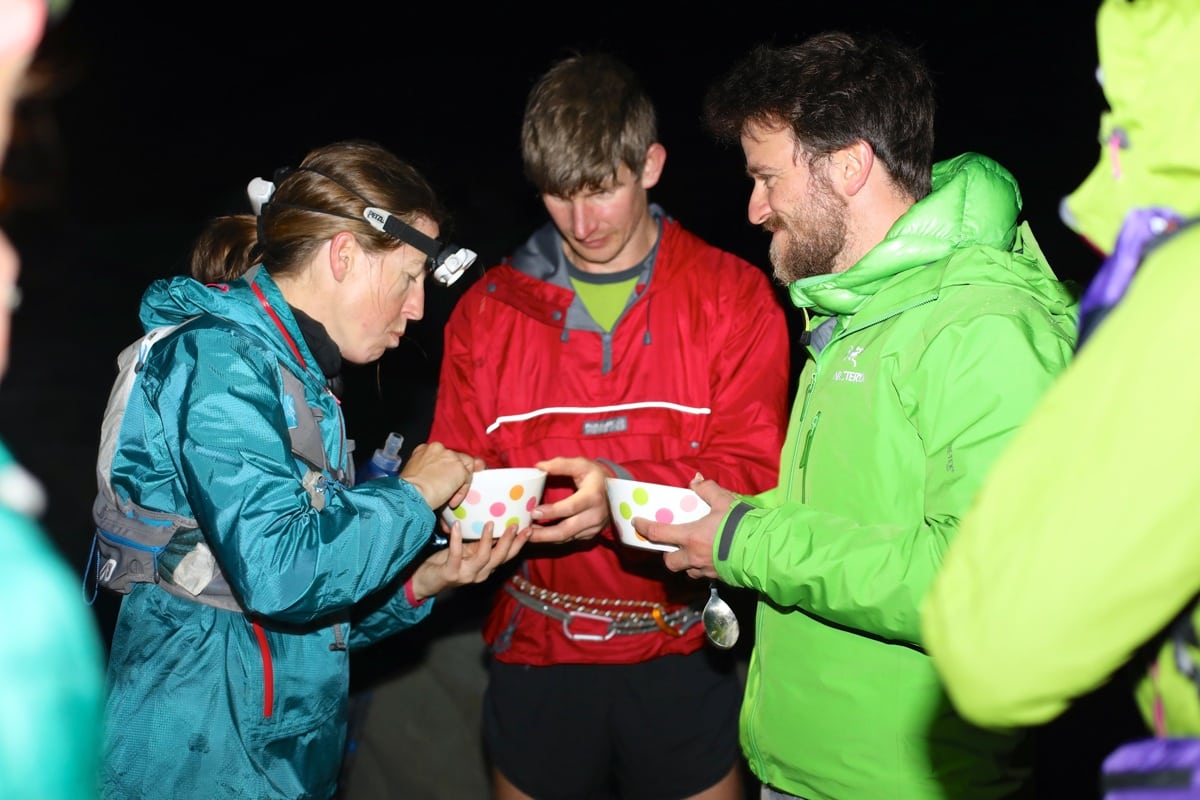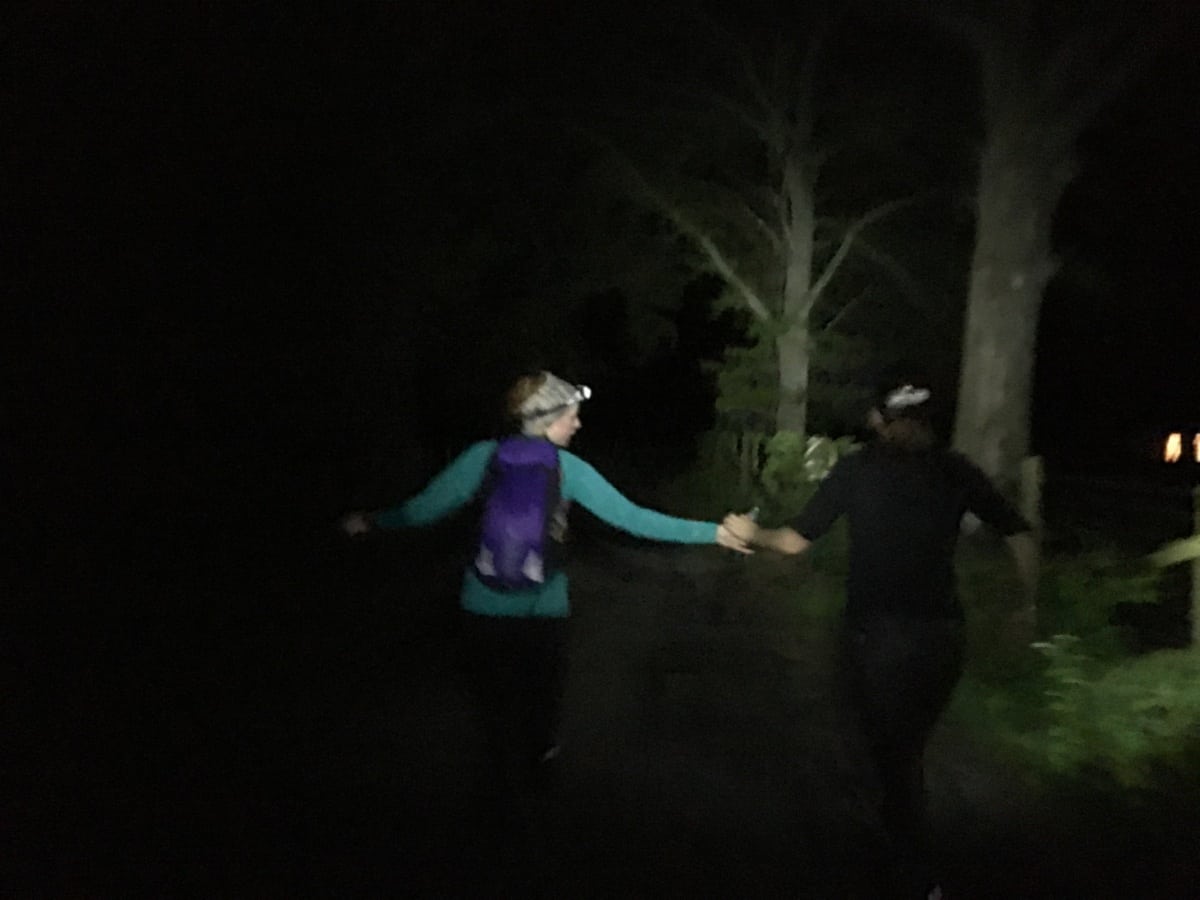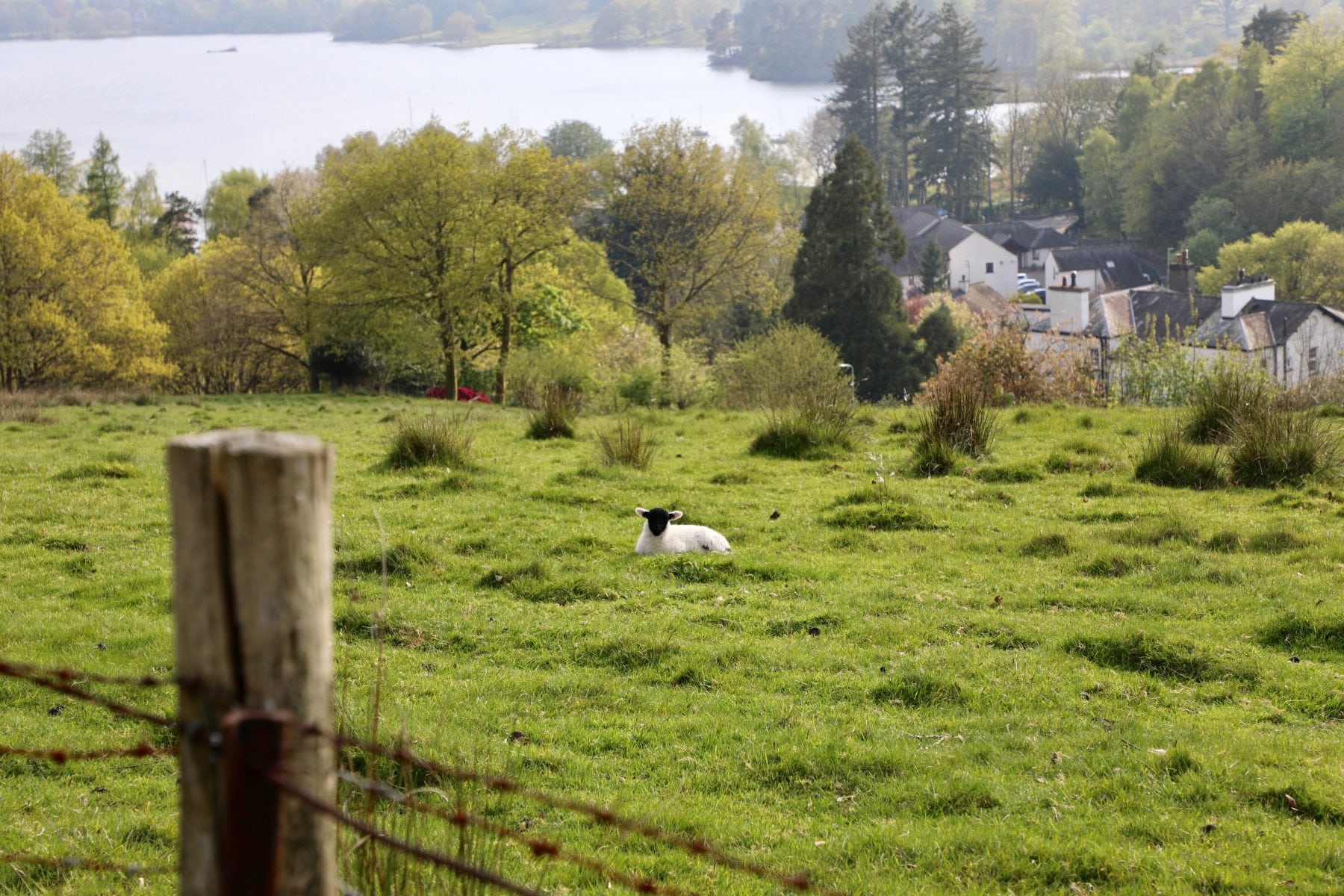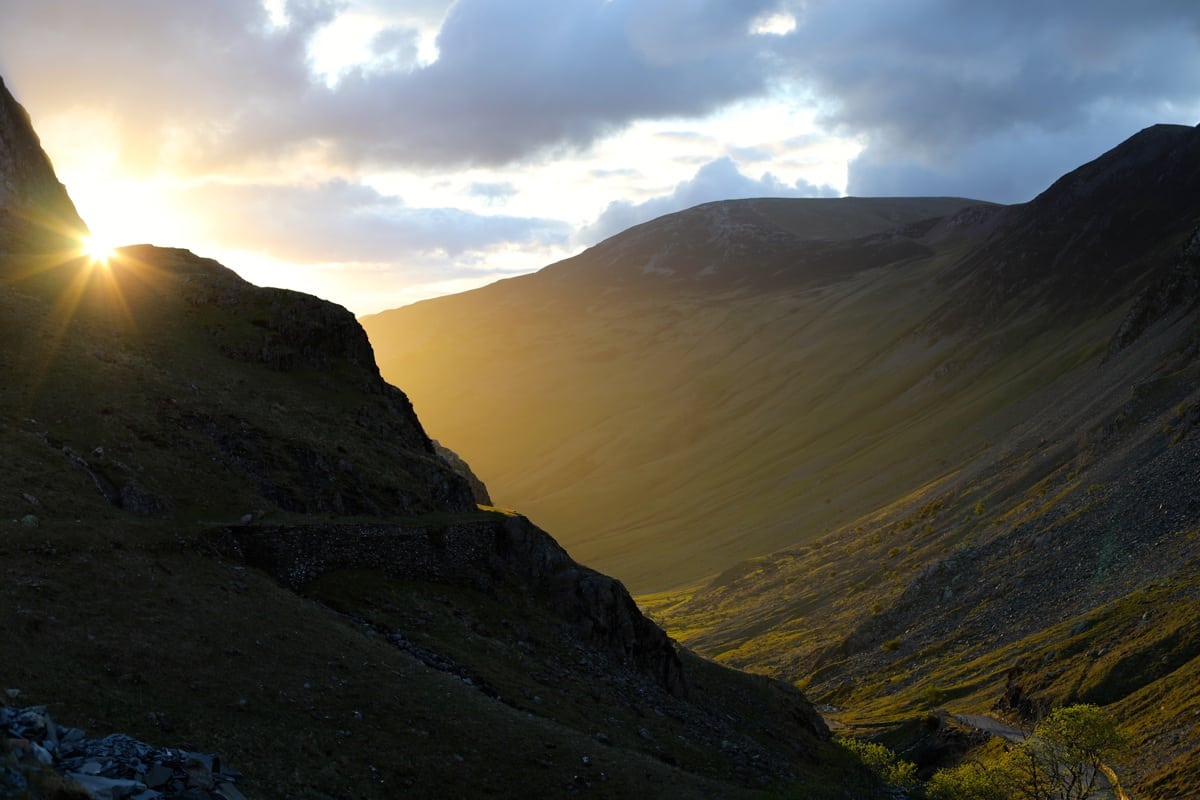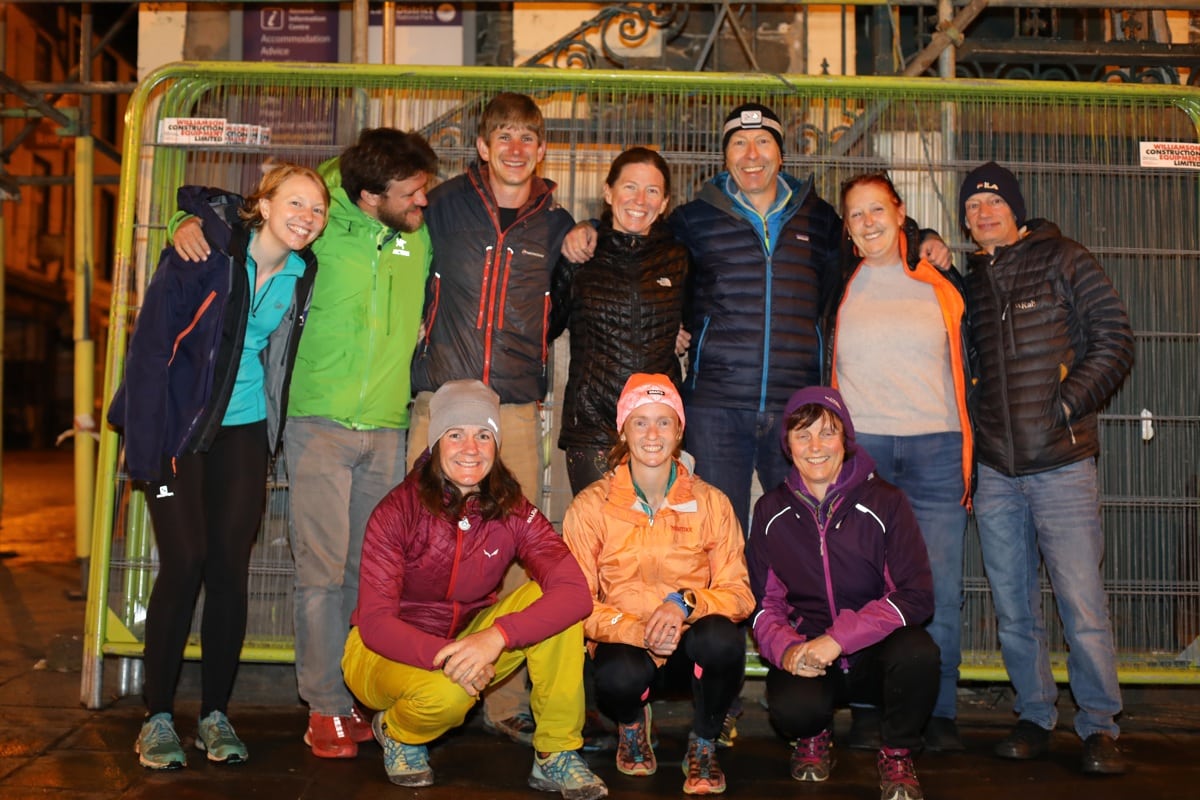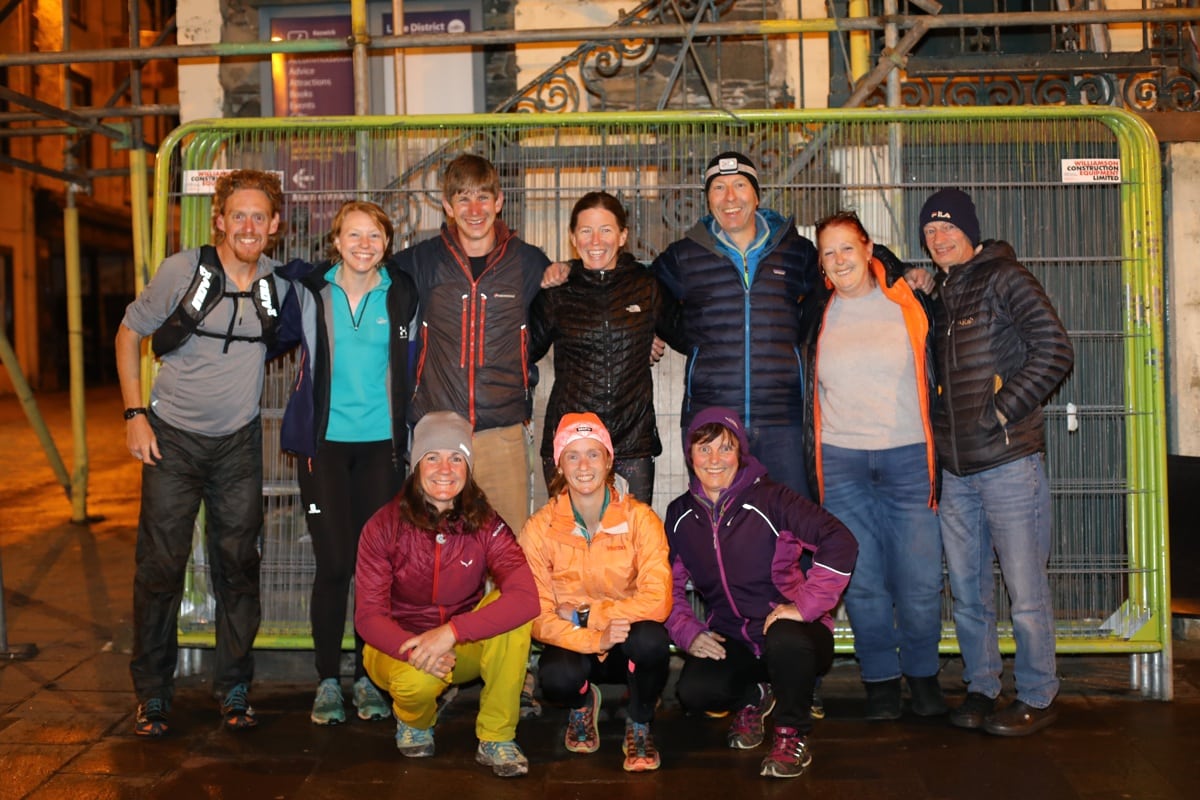How did the Bob Graham Round come to occupy a spot on my potential adventure to-do list? I don’t exactly know how it all started. Over the years, however, I’ve apparently mentioned my interest in this 66-ish-mile, 27,000-feet-of-climb route, which involves summiting 42 peaks in England’s Lake District in under 24 hours, enough times that a couple friends took it upon themselves to send me dramatic blog posts recapping attempts on the round, gorgeous videos and photographs of Lake District fells, and other forms of electronic temptation. Over the last year or two, I think, the idea moved out of the ‘if’ column of my to-do list and onto the one titled ‘when.’
The thing is, it’s not a logistically easy thing for an American to do. Most finishers of the Bob Graham Round (BGR) are from the United Kingdom (U.K.), and the majority of those people have put in a lot of time learning and training on the route. And, come on, planning and route recon is more than half the fun of such adventures! I knew that if I wanted to attempt the BGR, I wanted also to recce the whole route ahead of time, to do as due diligence as an American can of a route in a far-off place. Late last winter, as Bryon Powell and I mapped out which European races we would cover live on iRunFar this spring, we made the decision to spend four weeks in England in between them. This eventually manifested as a little over three weeks in the Lake District.
In that amount of time, I wouldn’t be able to learn the BGR as well as many people do before they attempt it, but I hoped that I could see and learn enough. That said, preparing for a 24-hour effort also should involve a multi-week and specific taper. Recceing the route and tapering are mutually exclusive practices! Thus, I needed to carefully balance recceing the route with resting enough ahead of time. In the end, I recced for eight days and tapered for eight more ahead of my attempt day. In doing so, I was able to see the entire route once, and about a third of the route a second time before d-day.
In lieu of loads of on-route experience, I hoped that I would be able to bank on a couple other factors. I have more than a decade of ultramarathon-distance experience and a couple decades of familiarity with off-trail, alpine travel. Oh, and I would finally (!!) be able to call back upon my childhood experience in Minnesota orienteering races. England’s Lake District has notoriously foul weather where clouds, fog, and rain obscure visibility and the lightly trailed and no-trail-signs nature of the BGR route means you have to navigate at times by map and compass. And the Lake District has bogs! I’ve been waiting a long time to use my Minnesota-running-through-floating-bogs-while-simultaneously-following-a-compass-bearing skill set!
Lastly and most importantly, I had the whole-dang Lake District (and beyond) seemingly on my side. Long-time iRunFar friend and contributing writer Morgan Williams is a BGR finisher and the Bob Graham Round 24-Hour Club’s secretary. When Bryon and I pulled the trigger on our Lake District trip, Morgan sounded the starting bell of the BGR’s ornate support network by calling his friends Steve and Wynn Cliff, who have supported hundreds of BGR and other big-round attempts in the U.K. With the combination of Morgan and his family, Steve and Wynn and their friend network, and a couple people who I know around England (or who’d be nearby at the right time), we developed a legion of support. I’d never seen anything like this before, such a large group of people dedicating more than an entire day to someone else’s running cause. Now that I’ve been through the BGR experience, though, I understand that this level of support is typical. Part and parcel to the BGR is this ornate form of selfless support. What a community fell runners have.
Pre-Attempt
Ultimately, I choose to start my attempt at 3 a.m. on Saturday, May 20. With this start time, the known quantities of sunrise and sunset that day, and my estimated pace–I am hoping to finish in between 22 and 23 hours–I should be able to use night at the beginning and end to traverse the easiest-to-navigate terrain and daylight hours to travel the more technical and challenging-to-navigate parts of the route. Basically, I want it to be light by the top of Blencathra, peak 3 on Leg 1, and I hope to get to Green Gable, near the end of Leg 4, by dark. Starting at 3 a.m. is the latest I figure that I can start and, if all goes okay, get around to Green Gable before dark.
Importantly, I want to sleep at least a little before my attempt. For all the time I spend not sleeping in covering ultramarathons live around the world for iRunFar and running a couple of my own ultramarathons each year, you’d think that I wouldn’t mind skipping sleep. But I love to sleep and I function a lot better when I’ve had some! I think that a couple of sleep cycles ahead of starting will keep me alert for all 24 hours.
That all said, a 3 a.m. start is probably the worst starting option for my road supporters, as they have two nights of disturbed sleep too but none of the fun of being out on the BGR route itself. Thank you, road support, for tolerating this start time!
Miraculously, I fall asleep at 7:30 p.m. the night before, and wake up feeling rested and alert a little after 12:30 a.m. My alarm is actually set for 1:30 a.m., though, but my body is apparently ready to go a bit earlier. I lay in bed until the alarm rings, and we hit the road from where we’re staying in Ambleside at 2:10 a.m. We arrive to Keswick with about 20 minutes to spare before go time. In the middle of the road on the drive is a massive roadkill badger, creatures known for their toughness. I decide not to consider the elemental irony offered here.
Leg 1
Moot Hall Depart: 3:00 a.m.
Skiddaw: 81 minutes split/1:21 elapsed/4:21 a.m.
Great Calva: 40 minutes split/2:01 elapsed/5:01 a.m.
Blencathra: 64 minutes split/3:05 elapsed/6:05 a.m.
Threlkeld Arrive: 30 minutes split/3:35 elapsed/6:35 a.m.
Total Leg 1 Split: 3:35 elapsed
Supporters: Sally Fawcett, Drew Sheffield, Claire Sheffield
The Bob Graham Round starts and finishes at Moot Hall in downtown Keswick, where Bob Graham himself did the same on his round back in 1932. According to the history books, Moot Hall has been a community hall of various sorts for centuries. Let’s say it’s an appropriate starting place, then!
When the clock strikes 3 a.m., we start our watches and trot off into the night. On Leg 1, I am accompanied by Sally Fawcett, Drew Sheffield, and Claire Sheffield. Sally is a fast English runner I’ve met at races a couple of times who is training for her own BGR. [Author’s Note: She just finished her round last weekend in 19:37. Congrats Sally!] I met Drew a couple weekends prior, as he helps put on the Centurion Running events and Bryon had run Centurion’s Thames Path 100 Mile a few weeks back. Drew and his wife, Claire, were already up in the Lakes crewing another person on a Friday BGR attempt, and have volunteered to stay on to help me. Gluttons, I tell you!
It is in the BGR’s style to fully support those attempting the route, to have people carry your food, water, and gear, and to help with navigation. Such a thing is unfamiliar in American ultrarunning culture, but I luxuriate in only carrying a light pack containing my water, a compass and navigation keys like compass bearings and a few written notes, my phone which contains my recceing GPS routes, and my SPOT tracker. In Leg 1’s case, Sally is the official navigator, and Drew and Claire the schleppers of stuff. We are a beastly team heading into the night.
Skiddaw, peak 1, is a walk-up. A very popular mountain for Lakes hiking enthusiasts, the trail is practically a highway from bottom to top. If it were America, I’m sure some jeep driver would try to drive this trail. Clear and calm skies accompany us through Leg 1, but they are particularly lovely as we powerhike our way up this first summit as stars glow upon us. It is joyful to watch the sky turn from the midnight blue of night to pre-dawn turquoise. We shut our headlamps off on the trod off the northeast side of Skiddaw.
While we had leisurely walked up Skiddaw despite the excitement of new beginnings, I catch myself climbing the second peak, Great Calva, harder than I want to. I ease off the gas on the two stair-step climbs going up the north side of Blencathra, the final peak of Leg 1. It’s here that the sun rises above the horizon and through the now-forming clouds and a bit of fog. We all delight at the scene. It’s the sort of beauty that doesn’t transfer well to words. You just have to get up and get out there early to see Mother Nature at her best.
There are multiple ways off Blencathra to close out Leg 1, and, with good visibility and dry rocks, we ultimately choose to come down the Hall’s Fell Trail. I had been quite slow in recceing this route down–it’s got some rocky ledges and multiple trails going here and there to start. Sally knows Hall’s Fell well and she rights us without issue all the way through the tricky bits. From about halfway down, we can see our road support waiting–Steve and Wynn’s campervan aside the road just above the village of Threlkeld.
I take just a few minutes to switch over from Leg 1 to Leg 2. Wynn has a buttie ready for me as per my earlier request, local code for an egg-and-bacon breakfast sandwich. When the moment arrives, I can’t take the whole thing on, but I pull two slices of bacon from the sandwich and dig in. Coffee, a small bowl of blueberries and raspberries, and we are off again.
Leg 2
Threlkeld Depart: 3 minutes split/3:38 elapsed/6:38 a.m.
Clough Head: 56 minutes split/4:34 elapsed/7:34 a.m.
Great Dodd: 28 minutes split/5:02 elapsed/8:02 a.m.
Watson’s Dodd: 8 minutes split/5:10 elapsed/8:10 a.m.
Stybarrow Dodd: 9 minutes split/5:19 elapsed/8:19 a.m.
Raise: 17 minutes split/5:36 elapsed/8:36 a.m.
White Side: 7 minutes split/5:43 elapsed/8:43 a.m.
Helvellyn Lower Man: 14 minutes split/5:57 elapsed/8:57 a.m.
Helvelyn: 6 minutes split/6:03 elapsed/9:03 a.m.
Nethermost Pike: 14 minutes split/6:17 elapsed/9:17 a.m.
Dollywaggon Pike: 13 minutes split/6:30 elapsed/9:30 a.m.
Fairfield: 35 minutes split/7:05 elapsed/10:05 a.m.
Seat Sandal: 22 minutes split/7:27 elapsed/10:27 a.m.
Dunmail Raise Arrive: 17 minutes split/7:44 elapsed/10:44 a.m.
Supporters: Howard Seal, James Elson, Sally Fawcett
On this leg, I am supported by local Howard Seal with his oodles of Lakes experience as my navigator. Also along as shlepper and general entertainment are James Elson, who owns Centurion Running and who is a BGR finisher himself, and Sally Fawcett again.
It is downright humid leaving still-asleep Threlkeld and heading uphill. I’m seriously not a fan of humidity–I live in a desert, people! Climbing a couple thousand feet back up in the mountains means that the air will cool and I’ll feel the humidity less. Chop, chop, let’s get back up high again! That said, I take the steeps of the Clough Head climb as easy as I possibly can.
Twelve peaks make up Leg 2, and 10 of them are located on a stunner of a mostly grassy north-south ridgeline. You do some hard work to make it up to the ridge at Clough Head, and you’ve got to rise some more to get onto the highest parts of the ridge, but Leg 2 is altogether dangerously runnable. The soft grass is an inviting running surface and pretty much everyone is still freakishly fresh at this point and it’s just about as beautiful as you can get. It would be very easy to get carried away in the romance of it all on Leg 2. And so we walk almost everything that has an uphill slant.
The clouds begin to close in as we near Great Dodd’s summit, and threaten to fully engulf us for the next several mountains. Soon a dark-gray mass of clouds fills the valley to the southwest of us. In front of it, tendrils of light gray clouds stream up, over, and around the mountains. Sheets of rain began to fall here and there, but not on us just yet. The day’s weather forecast isn’t a bad one: possible light showers and bouts fog–they call it clag here–in the morning, heavier but brief storms in the afternoon, and clearing into the evening.
The clouds close in officially on the digger ascent to Raise, and I finally put on my rain jacket. Little do I know now that I will wear this sucker for much of the next 15 hours! Atop Helvellyn, the highest peak on this ridgeline, we see the Old County Tops race checkpoint, a beast of a fell race connecting three of the local high points taking place today. It isn’t long after that when we catch a streaking glimpse through the fog of Rob Jebb and Josh Jardine leading the race and flying toward Helvellyn. So distracted by them, our general fun bantering, and deep in the murk now, we accidentally start descending the west side of Nethermost Pike instead of meandering east to its top. Oops! We lose about five minutes in getting back to the actual summit, Howard leading us with the map and compass, James feeling it out with his spidey senses, and me triplechecking against the GPS route on my phone.
There’s a beautiful grass descent coming off Dollywaggon Pike which reminds me a lot of the grassy side of Green Mountain on the Hardrock 100 course. As we bop our way down the grass, we lower below the cloud funk and cross paths with the bulk of the Old County Tops racers. Members of my team know some of them, some of them wish me luck by name, and several others ask if we are BGR attemptees and cheer us on when we answer in the affirmative. What a thrilling exchange of good energy!
The top of Fairfield, the 11th peak in Leg 2, is back into the clouds and, this time, pouring rain and even a bit of frozen graupel. My thoughts settle upon the word authentic. We’ve had stupidly good weather for the 2.5 weeks we’ve been in the Lakes so far, but now it’s looking positively northern England-esque.
With this expert team on my side, there is no mucking around, even though Fairfield’s got a flat top and its summit cairn can be confused with other large cairns marking the multiple routes on/off the mountain. Touch the summit and we’re off again, with just wee Seat Sandal between us and the completion of Leg 2. Such fun it is to rocket down Seat Sandal’s shoulder while peering upon the people gathered at the Dunmail Raise road crossing awaiting us.
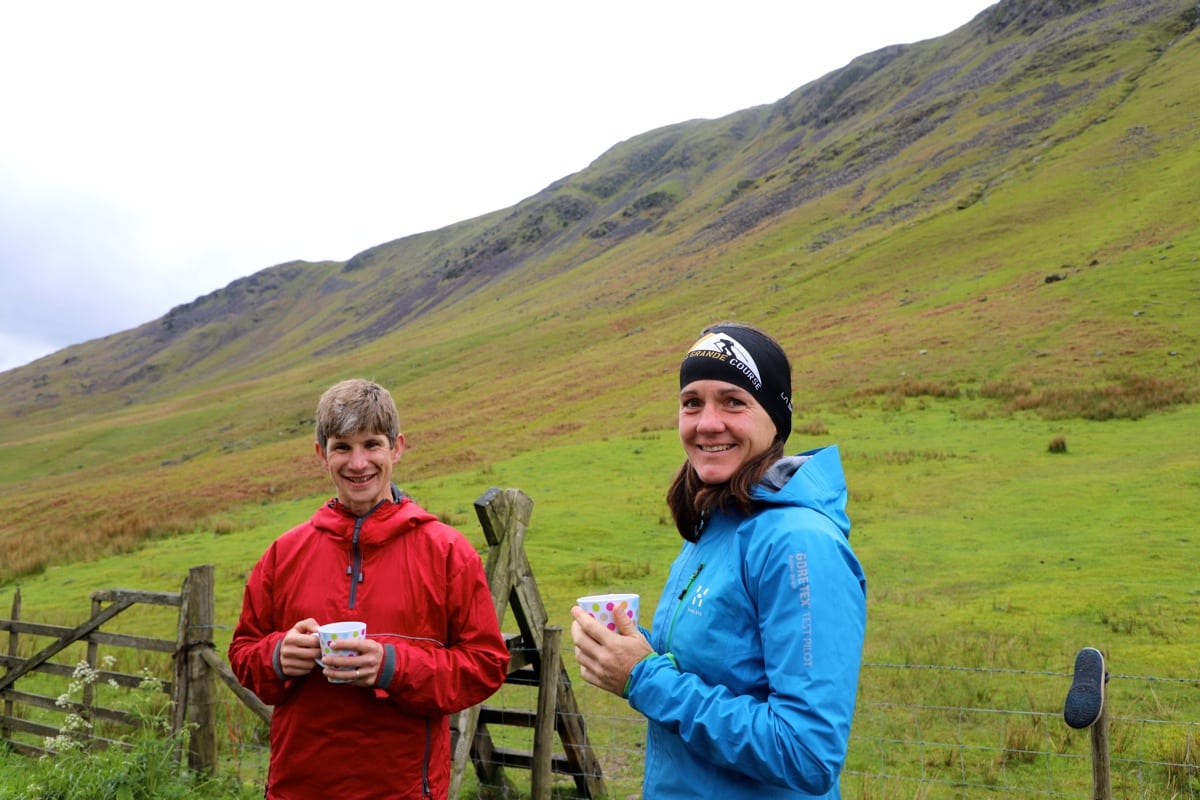
Tim Ripper and Tania Noakes enjoying a cup of tea at Dunmail Raise ahead of their pacing duties for Leg 3. Photo: iRunFar/Bryon Powell
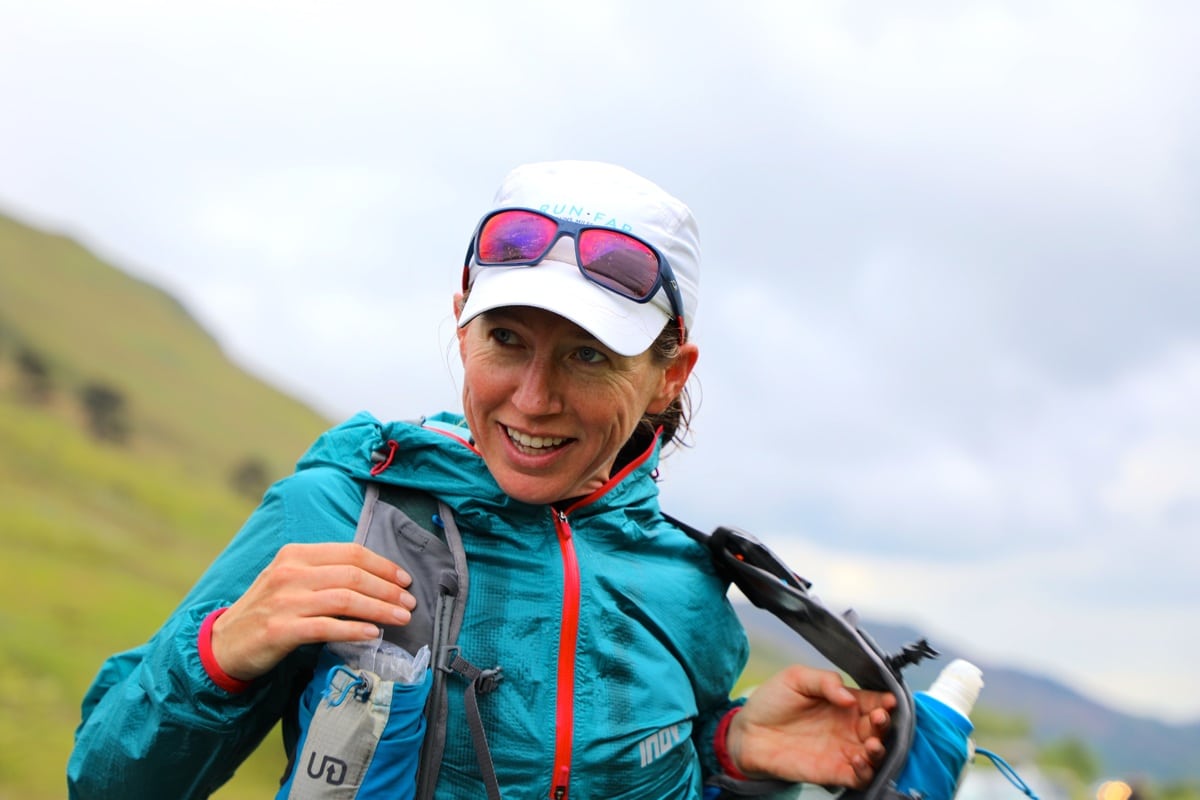
Meghan wearing a big smile coming into Dunmail Raise at the end of Leg 2. Photo: iRunFar/Bryon Powell
Leg 3
Dunmail Raise Depart: 5 minutes split/7:49 elapsed/10:49 a.m.
Steel Fell: 24 minutes split/8:13 elapsed/11:13 a.m.
Calf Crag: 23 minutes split/8:36 elapsed/11:36 a.m.
Sergeant Man: 31 minutes split/9:07 elapsed/12:07 p.m.
High Raise: 9 minutes split/9:16 elapsed/12:16 p.m.
Thunacar Knott: 14 minutes split/9:30 elapsed/12:30 p.m.
Harrison Stickle: 8 minutes split/9:38 elapsed/12:38 p.m.
Pike O Stickle: 14 minutes split/9:52 elapsed/12:52 p.m.
Rossett Pike: 46 minutes split/10:38 elapsed/1:38 p.m.
Bowfell: 32 minutes split/11:10 elapsed/2:10 p.m.
Esk Pike: 23 minutes split/11:33 elapsed/2:33 p.m.
Great End: 24 minutes split/11:57 elapsed/2:57 p.m.
Ill Crag: 16 minutes split/12:13 elapsed/3:13 p.m.
Broad Crag: 15 minutes split/12:28 elapsed/3:28 p.m.
Scafell Pike: 17 minutes split/12:45 elapsed/3:45 p.m.
Scafell: 44 minutes split/13:29 elapsed/4:29 p.m.
Wasdale Arrive: 35 minutes split/14:04 elapsed/5:04 p.m.
Supporters: Tim Ripper, Tania Noakes, Joasia Zakrzewski, Mae and Pip the Border Collies
It is Leg 3 that I am most intimidated about. I’ve read enough blog posts of BGR attempts unraveling here, of people getting lost in the rocky expanses in the clag; of others slowing to a wet, cold, and miserable halt when energy wanes; and of losing motivation in the growing fatigue haze of such an endeavor.
I am nervous, too, about some particulars of the navigation. I wonder if I can remember without referencing a map which of the Langdale pikes you do summit versus the ones you don’t on the BGR route, if I’ll remember how to find the ascent up Rossett Pike, and if I’ll be able to find and negotiate the Foxes Tarn route between Scafell Pike and Scafell in bad weather.
Turns out, I needn’t have worried about navigation because here I have another local, Tim Ripper, on my side. A BGR finisher and a helper of what has to be dozens of BGR attempts at this point, he knows the route inside out, even when the route is totally closed into the clag. Truth be told, his Border Collie, Pip, knows the route, too. When in doubt, follow Pip! Also on my team for Leg 3 is Tania Noakes, a Brit who lives in Chamonix, France and who works as a mountain guide. She could cartwheel the leg with her eyes shut and her legs tied together. Last but certainly not least, Jo Zakrzewski accompanies me along this section from Dunmail Raise to just before Rossett Pike. And if you know Jo, a Scottish friend who is in the Lakes for the weekend, you know she’s good for loads of storytelling and jokes. The scene is set for a no-fail Leg 3, in terms of support. Now I just have to hold up my end of the deal.
We make it up the steely steeps of Steel Fell and near the second peak of Leg 3, Calf Crag, before the weather closes in again. First it is higher clouds and decent visibility but a steady rain. Then, once we get up onto Sergeant Man and the Langdale pikes beyond, we are in the thick of the clouds for the rest of Leg 3. To be fair, I’d had brilliant weather for each of my three times recceing out here on Leg 3, so I’d seen it all already. But to also be honest, scenery inspires me and gives me energy and with nothing to see here today, my inspiration has to come from internal sources.
Bowfell has a bit of snow on it from the day’s storm, and the top’s boulder field is really confusing. Generally, I have a good feel for the direction I’m supposed to go even when I have no visual on it, but the black boulders on white murk leave me heading off the mountain in not even close to the right direction. “Just follow Pip,” Tim says. Sure enough, Pip’s scampering off at an angle of about 90 degrees to me. This is the first of several times that Tim and Pip will keep us on the right track.
We almost walk right past Great End, just a pile of boulders to the side of the main trail that is almost gone in the fog. It is Tania who notices the suggestion of the top as we pass it. In this bad weather, minutes are saved on almost every peak with my local team’s wisdom and expertise.
I find the rocky high country slow going. What was relatively easy on a dry recce day has me slowing way down to be careful on the rocks now slickened by water. My mind compares images of recceing pace versus my present pace and the comparison isn’t pretty. That said, a fall on some of these boulders could be painful if not dangerous. I know I am giving back time to the terrain to get across it safely, but there’s nothing else I can do.
The Foxes Tarn route isn’t fun for me. Full stop. We take a slightly more direct and scrambly line than what Joe Williams–Morgan’s nephew, a BGR finisher, and a really cool local who has become a friend during our time in the Lakes–showed me on our recce day here. Today, the scramble is wet grass and slippery rocks, and I am uncomfortable. I am about to pull the plug and ask Tim and Tania if we can retreat and take the lower and more secure way that we’d recced, but they full-on dive in and help me, Tim holding my foot steady on an icky hold and Tania lending an arm to yank me up. It is with their help that I make it through the nastiest step. Tears burn in the corners of my eyes and my sense of independence protests fiercely inside of me, but Tim and Tania hardly bat an eye. I guess this is an example of BGR culture that feels unusual and difficult for this American?
We successfully make it up, over, and down the rocky roof of England, which makes up the second half of Leg 2. Descending Scafell toward Wasdale, where I will be crewed, we lower out of the weather and into a heated sunny afternoon. The whole of valley that is Wasdale glows gloriously in late-afternoon sunlight. Just a half hour ago, we were up in shit weather, and given the look of the clouds clinging to the peak tops ahead on Leg 4, this is probably only a brief reprieve. But these minutes are horrifically romantic: fell upon fell upon fell circling one of the district’s most famous valleys. Though the fatigue of the previous 14 hours has begun its encroach upon the corners of my being–there is annoying grit in my shoes that’s poking at my toes and my knees are starting to talk to me and I have that fuzzy-ultra-brain feeling–the feeling of immersion into this place and this culture pushes the tiredness back and fills me with energy.
The road crew at Wasdale is upbeat and happy–it looks like an amazing in-progress party. They have more food available for us than a restaurant. I quickly settle in with a bowl of buttery potatoes and I watch Tim and Tania dive in to the feast, too. Though I’m now heated from the outside in courtesy of the descent into the nice weather, putting warm food into an empty belly still hits the spot. I’ve been feeding on 200 calories an hour until now, with a bit of extra food at the road crossings. Given the cold and wet weather of the last two legs and my current rate of potato inhalation, I’m beginning to realize that this probably isn’t enough. Nutrition for endurance efforts is the toughest nut to crack. Too much and you’re screwed. Too little and you’re screwed, too. And the target of the right amount of the right kinds of nutrition moves with every endeavor and its variables of length, climate, your fitness, altitude, and so much more.
Leg 4
Wasdale Depart: 8 minutes split/14:12 elapsed/5:12 p.m.
Yewbarrow: 47 minutes split/14:59 elapsed/5:59 p.m.
Red Pike: 48 minutes split/15:47 elapsed/6:47 p.m.
Steeple: 19 minutes split/16:06 elapsed/7:06 p.m.
Pillar: 31 minutes split/16:38 elapsed/7:38 p.m.
Kirkfell: 54 minutes split/17:32 elapsed/8:32 p.m.
Great Gable: 41 minutes split/18:13 elapsed/9:13 p.m.
Green Gable: 16 minutes split/18:29 elapsed/9:29 p.m.
Brandreth: 16 minutes split/18:45 elapsed/9:45 p.m.
Grey Knotts: 9 minutes split/18:54 elapsed/9:54 p.m.
Honister Pass Arrive: 14 minutes split/19:08 elapsed/10:08 p.m.
Supporters: Alicia Hudelson, Tim Ripper, Mae and Pip the Border Collies
As I visualized my BGR ahead of time, I planned to rocket out of Wasdale and up the wicked-steep climb to Yewbarrow, the first peak of Leg 4. Go easy for three legs and then hammer it home. I try pushing the Yewbarrow climb. It feels okay and almost hit the split I desire, but then I fizzle out. The other steep climbs of Leg 4–and there are plenty of them left–are plods. I’m usually able to rouse a hard final effort, but today I can see that it will be just me and my granny gear.
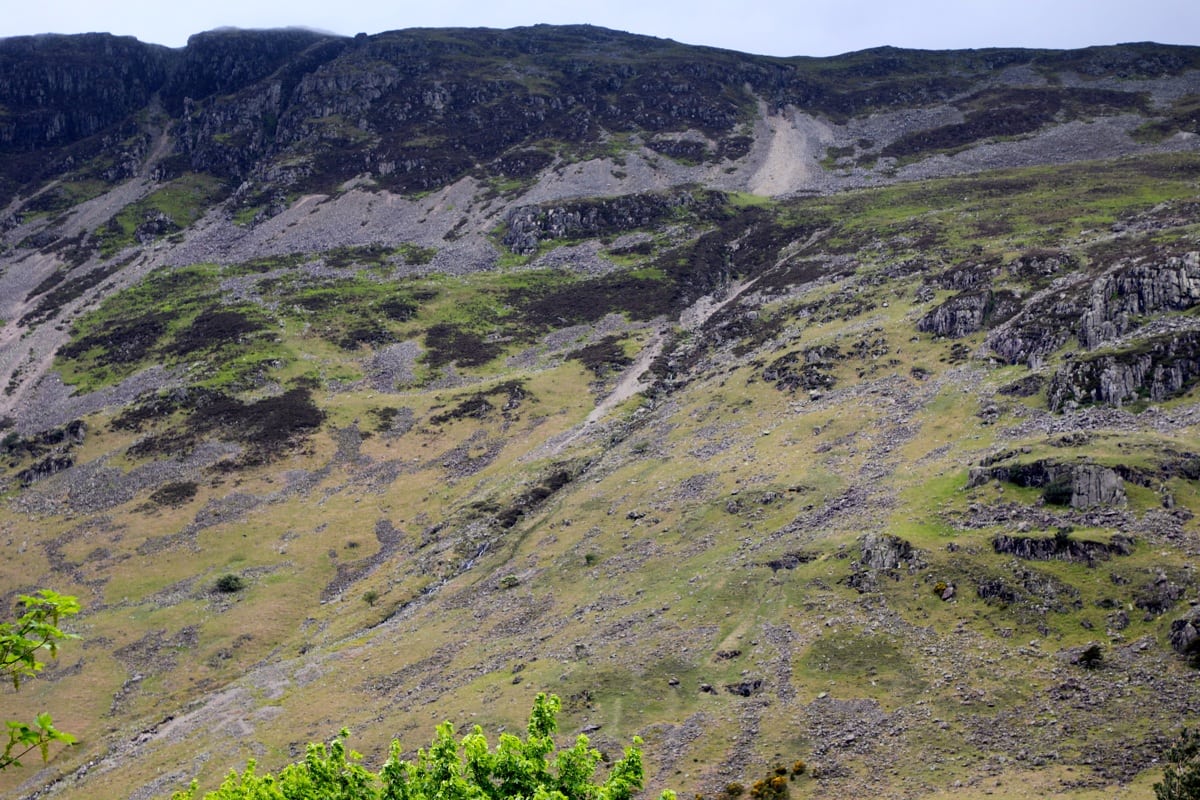
Meghan and crew (they’re there!) heading up the massive face of Yewbarrow to start Leg 4. Photo: iRunFar/Bryon Powell
The hindsight of the two months that has intervened between running the BGR and publishing this report offers the probable answers for why I couldn’t deliver on a smooth and strong end to my effort. First and foremost, I didn’t nail my nutrition on Leg 3. I ate 200 calories an hour of simple carbs and a little fat, which would have probably been plenty on a good-weather day. But the metabolic needs of operating in Leg 3’s shit weather were likely higher than that. Next, I think my taper was too short for the duration of this event and the residual fatigue of the hard training weeks I’d done in the month prior likely reared its head here. Finally, my fitness was still developing for the year and perhaps it was unreasonable for me to expect that I could finish that hard when I hadn’t put in enough training to support it.
My Leg 4 support is a combination of new and old blood. Tim and the Border Collies are not tired from the more than six hours of Leg 3, and they join me for some more fun on Leg 4. No, not even a smidge tired, none of them! Fell runners, I tell you! I’m also joined for this leg by American Alicia Hudelson, who is a BGR finisher too, and who is currently in Scotland.
On the tops of Leg 4, we remain in thick clouds, but as we dip into the passes, we sometimes lower below them for just a few minutes. From the low point between Pillar and Kirkfell, we see that the land is bathed in bright orange sunset light. Just above us, the thick deck of clouds is black-grey, and it rises and falls like some dragon above is breathing it in and out. The scene below us offers a sense of heart-filling warmth, and the scene above all the spookiness of Halloween. Again I have tears in my eyes, though these are pulled across my face by a fierce wind. I know that this scene is simply the ordinary proceeding of Mother Nature as she closes the curtain of night upon the Lakes, but I am filled with a profound sense of gratefulness that we are here to bear witness to natural order.
Here on Leg 4, food is immediate fuel. As soon as I eat something, I experience a burst of energy, one that also fades quickly. I ride the highs and lows of energy and terrain as best as I can. Ascending the steep Joss’s Gully to Kirkfell, Alicia dangles snacks in front of me like carrots. “How about a little piece of Kit Kat?” “Up for an Oreo?” The scene is infantile, comedic, and quintessentially ultrarunning.
I may not be in my physical peak in the last legs of my BGR attempt, but I refuse to waver a millimeter in mental focus. I won’t stop until this is done now. Though my pace is slowing, we still make it up and over Green Gable before dark. We actually make it to the descent off this leg’s final top, Grey Knotts, before I turn on my headlamp. Yip!
The energy of my road crew at Honister Pass is high, and so is mine. They know I will finish. I know I will finish. It’s just a matter of the three remaining peaks and a little road run back to Moot Hall now.
Leg 5
Honister Pass Depart: 2 minutes split/19:10 elapsed/10:10 p.m.
Dalehead: 42 minutes split/19:52 elapsed/10:52 p.m.
Hindscarth: 20 minutes split/20:12 elapsed/11:12 p.m.
Robinson: 29 minutes split/20:41 elapsed/11:41 p.m.
Moot Hall Arrive: 103 minutes split/22:24 elapsed/1:24 a.m.
Supporters: Caroline Holmes, Bryon Powell
With just three tops remaining, this is the glory leg. Unfortunately, I don’t have much–read: anything–left in my climbing legs so we’re relegated to a turtle-like meander. Night is closed tightly in; it is black up here. And the higher we go, the thicker the clouds get. The final couple hundred feet of each top is mucked up with fog. No matter, Bryon is here with me and he and I recced the route together last weekend. Caroline Holmes is also here, and she’s a local fell runner who knows this BGR leg well.
Boom, boom, boom, we tick off Dalehead, Hindscarth, and Robinson, peaks 40, 41, and 42. I want to celebrate a little on Robinson, but I want more to get off this mountain. I am giving back time from my splits on the uphills, so I feel a strong need to keep pressing ahead.
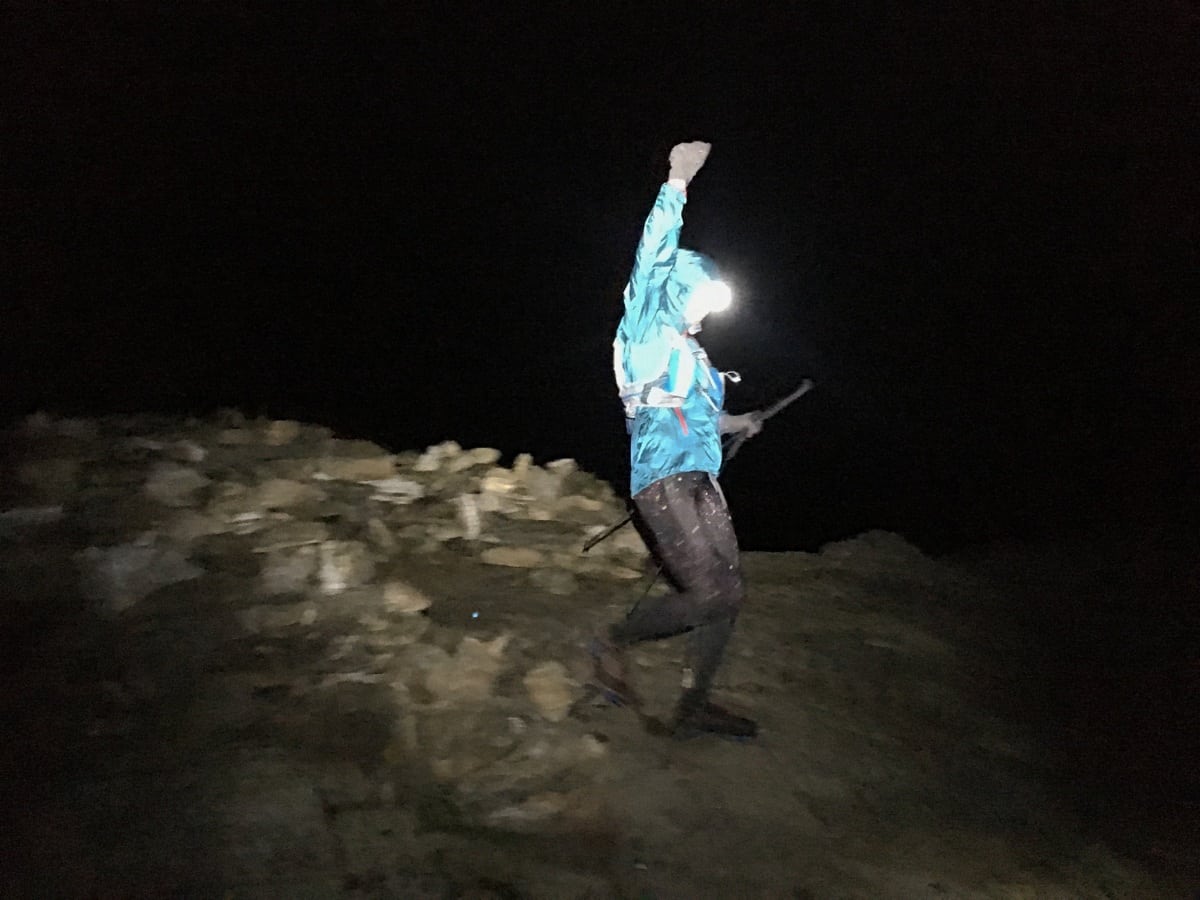
Meghan celebrates after summiting Robinson, the 42nd and final peak of her BGR. Photo: iRunFar/Bryon Powell
There is the little problem of the rocky ledges off Robinson. Last weekend, we’d recced two ways around them, but I still somehow end up right on them–this is my worst navigation error of the round. They are wet and slippery, and it takes me many minutes to lower myself the couple hundred vertical feet through them.
Once we are off of the rocks, we are moving again, back into a run for the final miles of trail and then the five-ish paved miles back to Moot Hall. Leg 5, courtesy of my slow uphill pace and the 15 or 20 minutes lost on the Robinson ledges, offers me some psychological stress. I’m a stress puker, and so I know it’s coming before it hits. As soon as we reach the trail and start running and my heart rate increases, up comes the contents of my stomach–the fruit from the last crew station and lots of liquid. But once it’s up and out, I’m good to go.
My pavement running form is fatigued by the elements of the day, but still intact overall since much of the motion I did in the 21.5 hours before now did not resemble this. It actually feels good to just… run. We quietly cruise the back roads of the Lakes, and I laugh to myself as I remember driving them and others. They are narrow, just one car wide in many places, and lined on both sides by ancient rock walls tall enough to keep sheep where they are supposed to be–in the fields. When you come upon a car, you hope there’s room for one to pull out to let the other pass. And if there isn’t an immediate pullout, someone’s gotta’ back up until there is. Add into this the general confusion of me driving on the left side of the road and it’s just nonsense. For an unaccustomed American, the roads of the Lakes are its most torturous entities. I decide as we run back to town, Running the BGR is easier than driving the Lakes’s roads.
I revel in the final mile into town as the night begins to light up with house and street lights. I’d read many blog posts about Keswick pub goers cheering in late-night BGR returnees, and so I’m elated to find that they are out on the streets en force and happy to help cheer me in. The pub culture of England is as ornate and well-developed as its fell-running culture. Well, I suppose they go hand in hand, don’t they?
Almost my entire crew awaits me at the hall. It’s the middle of the night and these people look weary too, but here they are with giant smiles on their faces. With a feeling of levity courtesy of everyone around me, I bounce up the steps of Moot Hall, touch the door, and stop my watch. It’s 1:24 a.m. on Sunday, May 21 now, and I complete my round in 22 hours and 24 minutes. I may have done the running, sure, but running is just a small part of something such as this. All these people did the crewing, the cooking, the pacing, the navigating, the gear schlepping, the force feeding, the storytelling, the hugging, and the loving. Becoming a Bob Graham Round finisher is, in my case, a group effort and group adventure.
It is an experience of standing on the shoulders of giants.
Some Thoughts on Fell Running and Bob Graham Round Culture and Environmental Ethics
The Lake District of England has many unique qualities. First, the weather is regularly poor. It’s the wettest region of England, which is saying something because England is a wet country. The data show that Sprinkling Tarn, a tiny lake which sits in the shadow of Scafell Pike, receives the most rainfall in England. The climate is maritime, with the North Atlantic Current–the main movement of the North Atlantic Ocean–being largely the climate controller in bringing clouds, precipitation, and wind off the ocean and into the U.K.
Next, the people who live there are tough and capable. Historically and modernly, the region’s inhabitants are pastoralists–mostly of sheep, but also of cows and other accessory animals–who moved about the land to grow and graze them. It was and is the low pastures in the winter, and high on the fells for the herds by summer. Recreation in the forms of climbing, hiking, running, biking, and more have been secondary ventures in this region. That said, the tradition of fell running, for instance, is ancient by the modern-era trail running standard. For hundreds of years, the Lakes’s residents have run and raced upon their fells. Today, the Lake District is a popular outdoor-recreation destination for both locals and out-of-towners. No matter the weather, a spring, summer, or fall day will see thousands of recreationists upon the fells.
And then there is the unusual landscape itself. Very broadly, fells are high, open, above-treeline mountains. Some fells are wide-reaching, curvy, and grassy. Others are rocky, cliffy, and void of much that is living. For a North American, think the tundra-scapes of our alpine West or Alaska. For instance, Alaska’s Brooks Range and the Lakes’s fells share some aesthetic similarities. Today the fells are still used for sheep grazing, but they are also used by recreationists. There are thousands of miles of trails tracing back and forth across them, almost all of them without signs or other forms of navigation help. And there is plenty of off-trail territory up there, too.
The fell runners I met are among the toughest and most capable runner-types I have encountered. In bad weather, everyone runs around with a map and compass in their hand or strapped somehow to the front of their body so that they are immediately accessible. They run no matter the conditions–gale-force winds and rain do not stop them from running and racing. They are incredible technical runners. On trail and off trail, over spongy grass and wet rock, they fly. The steeps, of which the Lake District has loads, are no match for them.
The Bob Graham Round is one of many challenges–in and out of the racing environment–a person can set their sights on in the Lakes. Once a thing enjoyed by a few local fell runners, interest in the BGR is spreading beyond the Lake District now. People from all over the U.K. are training and making attempts on the round. A typical summer weekend might see a dozen people attempting the round and loads more training on it. Even people like me, from places way far off, are taking interest now. There’s a guy called Kilian Jornet who says he’ll take a shot at the round later this year.
Originally, the BGR was a largely off-trail route. People could travel by whatever path they wanted to hit the 42 tops Bob Graham himself did. Now, in all the intervening years since Mr. Graham’s 1932 round, a trail is developing along the most common paths between the summits. In some places, the path is wide, the trench deep, the hill eroded, the heather trampled. That is, the impact BGR hopefuls make on the land is noticeable. What is physically there now that once was not is proof of the impact of trail runners on the landscape.
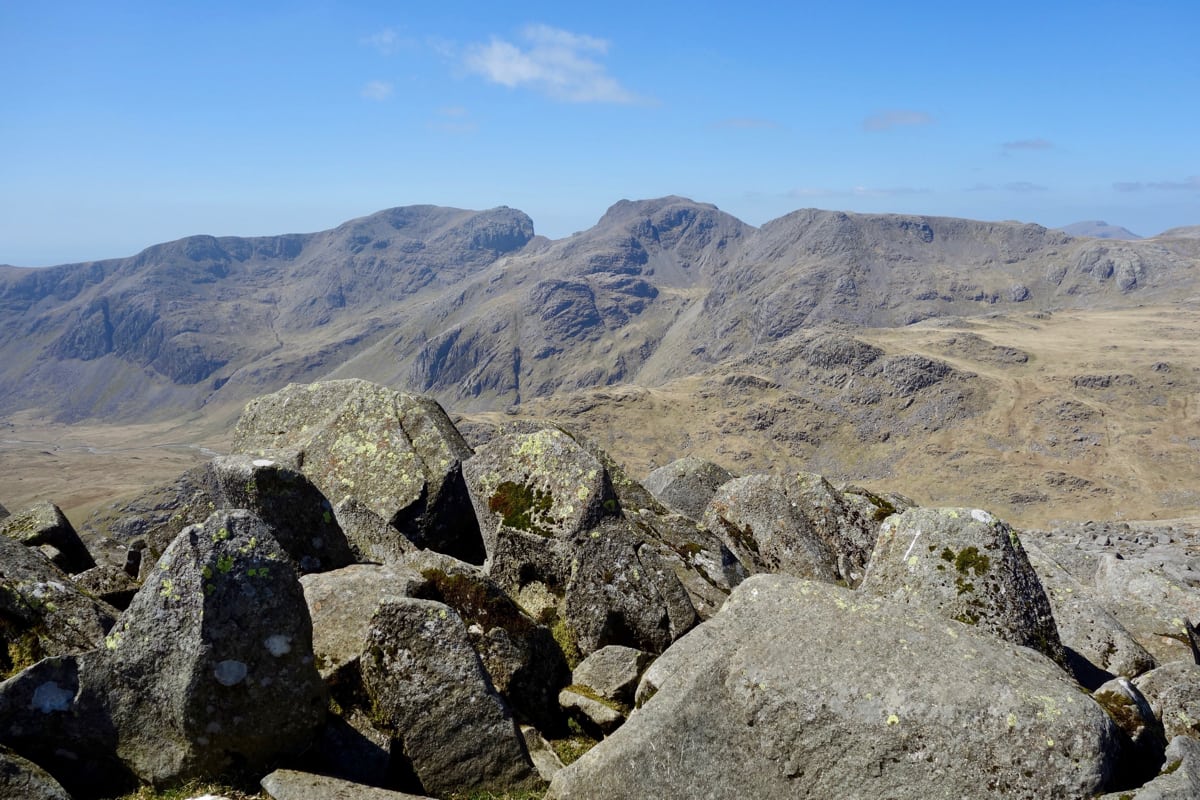
Looking from Bowfell to Scafell Pike (back center) and Scafell (back left) along the Bob Graham Round. Photo: iRunFar/Meghan Hicks
This situation is not unfamiliar in my home country, either. I see direct physical impacts upon the landscape by trail runners with increasing frequency. As I ready this article for publishing, I’m holed up, living in my car in the Sawatch Mountains of Colorado, training on the Nolan’s 14 line. Conceptually, the Nolan’s 14 line–a link-up of fourteen 14,000-foot peaks in this mountain range by largely off-trail travel–is similar to the BGR, except that it is longer, harder, newer, and far less frequently experimented upon by trail runners. Yet the impact of trail runners on it has been increasing since 2012, when I first traveled on the line. Today there are little paths in places–especially wet places where a footstep goes deeper and stays longer than others. And there are cairns, too.
Spending several weeks in the Lake District, running the BGR, falling in love with the place and people, and seeing the impact that I and others have had on the fells, I hemmed and hawed for a full two months in publishing this article. In doing so on a platform as large as iRunFar’s, one that reaches a global audience of many thousands, I draw more attention to the BGR. And attention can eventually lead to impact. This is a thought that haunts me at night these days. It is time for me and all of us trail runners to acknowledge, understand, and address our impact upon the land.
The keepers of the fells in England and of the BGR are, like, 97 steps ahead of us on this one. Of course they are! Fell running is an ancient sport compared to the trail running we do in the rest of the world. Since the 1930’s, the U.K. has had The Country Code (later called The Countryside Code), a set of rules for travel and recreation in common lands like the fells. And the Bob Graham Round 24-Hour Club has developed its own set of rules for engagement on the round (that are explained in significant depth here, too). These guidelines establish a set of ethics for BGR travel that require users to respect the land, the local culture, and the region’s history. North American readers might find that some of this material runs parallel to the parameters of front and backcountry travel established by Leave No Trace, a United States-based nonprofit dedicated to educating outdoor users on how to minimize their impact.
The Lake District is an exquisite place and it contains an exquisite community of people. My experience there is a gift I will hold tight in my heart for a good long time. After a couple months of indecision, I am publishing my Bob Graham Round report with the hope that, if it inspires anything, anyone, anywhere, that it will inspire sustainable, caring, conscious, loving action. The Lake District loved me, and all I want is for someone to love it back.
Other Details
Road Support: Steve Cliff, Wynn Cliff, Morgan Williams, Alison Eagle, Joe Williams, Bryon Powell
Gear:
- Inov-8 Women’s AT/C Merino Long Sleeve Mid Layer With Hood
- Inov-8 Women’s AT/C Stormshell Waterproof Jacket
- CW-X Women’s Stabilyx 3/4 Tights Print
- Injinji Women’s Ultra Compression OTC
- Inov-8 X-Claw 275 shoes
- Ultimate Direction SJ Ultra Vest 2.0
- Black Diamond Z Pole original version
- Petzl Nao original version

Meghan’s Inov-8 X-Claw 275s after making it around the full BGR with her. Photo: iRunFar/Bryon Powell
Thank You:
Thank you to the 17 people who dedicated all, part, or more than a day to my Bob Graham Round attempt. My heart is so big for all of you. Thank you also to Inov-8 for its support of my attempt.
